
* The emergence of the combat jet in the postwar era meant that the US Navy (USN) had to acquire jet aircraft to keep up with the advance of technology. The first carrier-based pure jet fighter acquired by the service, the McDonnell "FH-1 Phantom", was inadequate, but it led to a scaled-up successor, the "F2H Banshee", that was a significant component of the Navy's carrier air power well into the 1950s. This document provides a history and description of the Phantom and Banshee. A list of illustration credits is included at the end.
* The McDonnell Aircraft Corporation was founded in Saint Louis, Missouri in 1939 by James McDonnell. By 1940 the company was busy building subassemblies for other aircraft manufacturers as the US geared up for war, but McDonnell engineers were also able to come up with a design for a heavy long-range fighter with twin piston engines for submission to the US Army Air Corps. After some design iterations, the Army was interested enough to order two prototypes. Work on the aircraft was protracted, with the Army nearly canceling the effort, but the first "XP-67", called the "Bat" or "Moonbat", finally took to the air on 6 January 1944, with test pilot E.E. Elliot at the controls.
The Moonbat, as its name hints, was an unusual aircraft, featuring what would later be called "blended wing-body" features -- the wing merging smoothly into the fuselage to maximize lift, giving it something of a 1940s retro sci-fi appearance. It had a span of 16.76 meters (55 feet), a length of 13.65 meters (44 feet 9 inches), and an empty weight of 8,050 kilograms (17,745 pounds). The XP-67 was powered by twin Continental XI-1430 12-cylinder inverted-vee water-cooled engines with General Electric D-23 turbochargers and thrust-augmenting exhausts, each engine providing 1,010 kW (1,350 HP) for take-off. An engine was fitted into a streamlined nacelle in each wing, with the engines driving four-bladed propellers.
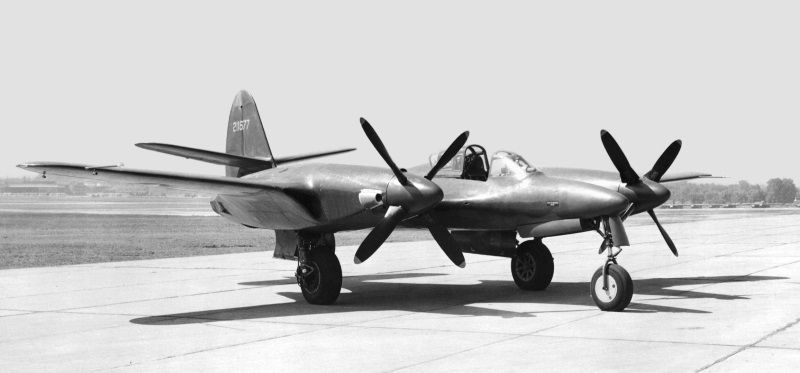
The aircraft was fitted with tricycle landing gear, all gear assemblies featuring single wheels and all retracting backward, the main gear tucking up into the engine nacelles. The production aircraft was to have cabin pressurization and armament of six 37-millimeter cannon, with the guns mounted in wings inboard of the engines -- though the prototype was unpressurized and unarmed.
The Continental engines didn't deliver rated power and proved temperamental, often forcing test flights (including the first one) to be cut short, and on 6 September 1944 Elliot was forced to get back on the runway in a hurry when an engine caught fire. The aircraft was badly burned. By that time, everyone had become discouraged over the problems with the engines, and there was no longer a real perceived military need for the XP-67 anyway. The program was canceled in October, the second prototype never being completed.
* McDonnell engineers might have had reason to be depressed over the failure of the XP-67 program, but by that time they were busy enough on another, even more advanced fighter to keep them from brooding. In 1942, the US Naval Bureau of Aeronautics requested that McDonnell design a jet interceptor to operate from aircraft carriers, and in early 1943, the Navy awarded a contract for two prototypes of the new fighter, to be designated "XFD-1".
McDonnell's design team, led by Kendall Perkins, was given only the most general specifications from the Navy, giving the engineers considerable freedom in their decisions. They chose to design as simple and conservative an aircraft as possible, to minimize risk as well as ease manufacture and maintenance. The McDonnell design team worked with Westinghouse on powerplant fit, considering various configurations, finally settling on an engine installed in each wing root.
Work on the prototypes began in January 1944, the first prototype flying on 26 January 1945 with test pilot Woodward Burke at the controls. This was just a brief hop, since only one engine had been installed; the first twin-engine flight took place a few days later. The second prototype followed it into the air soon after, with the two machines successfully passing company and initial Navy trials. On 21 July 1946, an XFD-1 began carrier trials on the USS FRANKLIN D. ROOSEVELT, making it the first US jet aircraft to operate off a carrier.
The Navy had already placed a production order, for 100 aircraft, in March 1945, to be initially designed "FD-1". However, the "D" code had traditionally been assigned to Douglas aircraft; when the Phantom was ordered the Navy was not obtaining any Douglas machines, but that changed, and so the designation of the Phantom was altered to "FH-1". The initial production machine performed its first flight on 28 October 1946, with first deliveries to the Navy in 1947.
* The FH-1 Phantom was a neat, sporty single-seat aircraft of conventional configuration, built mostly of aircraft aluminum, with low-mounted straight wings featuring an engine in each wingroot; a tail assembly with the tailplane mounted at the base of the tailplane above the fuselage; a raised cockpit; and tricycle landing gear. The wing folded straight up outboard of the main landing gear, and featured ailerons and split flaps, with a solid-panel spoiler-type airbrake on the top of the wing outboard of the wing fold. The tail assembly was nothing unusual, featuring elevators and rudder; the wing and tailplane had noticeable dihedral.
The engines were Westinghouse J30-WE-20 turbojets with 7.1 kN (725 kgp / 1,600 lbf) thrust each, with the exhausts canted slightly outward to protect the rear fuselage. Two "jet-assisted take-off (JATO)" rocket bottles could be attached for boosted take-offs if desired. Internal fuel supply was 1,420 liters (375 US gallons).

The pilot had a good field of view, with the canopy sliding back over the spine of the aircraft to open; the pilot did not have an ejection seat, though the canopy could be discarded in an emergency to make escape easier. All landing gear assemblies had single wheels, with the nose wheel retracting backward, the main gear hinged in the wings and retracting inward. The landing gear configuration gave the Phantom a wide ground track, making it stable in ground handling. There was a stinger-type arresting hook under the tail.
Armament consisted of four 12.7-millimeter (0.50-caliber) M2 Browning machine guns on the top side of the nose, with 325 rounds of ammunition per gun. There were also stub launchers under the wings for eight 127-millimeter (5-inch) HVAR (High Velocity Air Rocket) projectiles, though rockets were rarely carried. A conformal belly fuel tank with a capacity of 1,117 liters (295 US gallons) could be attached.
Production FH-1s differed from the XFD-1 prototypes in being 48 centimeters (19 inches) longer to provide more fuel capacity; having a tailfin with a squared-off top, instead of the round-top tailfin of the prototypes; and being fitted with a smaller tailplane. In service, the FH-1s were generally painted in overall dark sea blue, the typical USN color scheme for the time.
__________________________________________________________________
MCDONNELL FH-1 PHANTOM:
__________________________________________________________________
wingspan:
12.4 meters (40 feet 9 inches)
folded wingspan:
5 meters (16 feet 3 inches)
wing area:
25.6 sq_meters (276 sq_feet)
length:
11.8 meters (38 feet 9 inches)
height:
4.32 meters (14 feet 2 inches)
empty weight:
3,030 kilograms (6,680 pounds)
max loaded weight:
5,460 kilograms (12,035 pounds)
maximum speed:
770 KPH (480 MPH / 415 KT)
service ceiling:
12,525 meters (41,100 feet)
range:
1,115 kilometers (695 MI / 605 NMI)
__________________________________________________________________
Only 60 FH-1s were actually built, since the end of the war ended any urgency for obtaining jet fighters, and though the Phantom was apparently a very pleasant aircraft to fly it was also underpowered, not much faster than the best piston fighters. It also had much less range.
The Phantom served with one Navy and two Marine squadrons. The Marines formed up one of the very first jet flight demonstration teams, the "Flying Leathernecks", with bright yellow nose and trim, for appearances at airshows. The Navy also formed up a three-man Phantom demonstration team, the "Gray Angels", whose aircrew were all admirals. All FH-1 Phantoms were out of first-line service by the end of 1949, being replaced by the McDonnell Banshee, discussed below. The Phantoms were passed on to Navy Reserve squadrons, where they put to good use converting Reserve pilots from piston fighters to jet fighters, up to the FH-1's final retirement from military service in 1954.
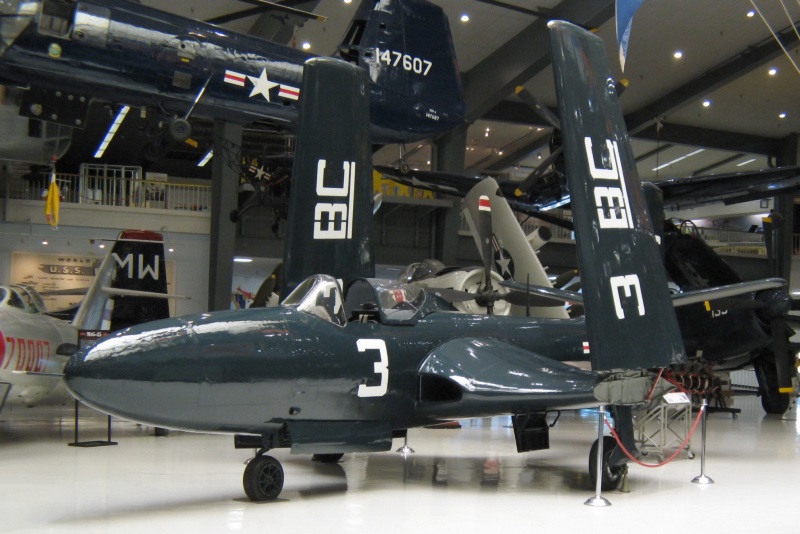
Although the FH-1 Phantom had a short service life, it served a useful purpose in familiarizing the Navy and Marines with carrier jet operations. In the early 1960s, a Florida-based company bought up three demilitarized Phantoms for training commercial pilots on jet operation, but the venture was not a success. A few FH-1s remain on static display, but none are flying any longer.
BACK_TO_TOP* Even before the FH-1 Phantom went into production, McDonnell had been considering a "bigger and better" Phantom for the Navy, with higher performance and more range. In March 1945, only weeks after the first flight of the Phantom, the Navy ordered a single prototype of the improved machine as the "XF2D-1".
The new machine had an unmistakeable resemblance to the Phantom, with very much the same overall configuration including similar folding wing, tail, engine, and landing gear arrangement. However, the XF2D-1 was not merely scaled up in all regards; it was an entirely new aircraft with little or no parts commonality with the Phantom, and many detail differences.
Armament was heavier, with four M3 Hispano-type 20-millimeter cannon under the nose, the position of the guns having been relocated because the muzzle flash of the Phantom's top-mounted Brownings tended to blind the pilot during night firing. The cannon had an ammunition load of 150 rounds per gun. The main gear retracted outward into the wing, not inward; the air brakes were changed from a solid to a perforated format; and the nose gear could fold down on the ground to put the aircraft into a "kneeling" configuration, with two little wheels extended to support the aircraft's nose -- the idea being that this would make servicing simpler, and allow tighter packing of aircraft parked on a carrier deck. The canopy was streamlined and updated, though it still slid back to open, and the pilot sat on an ejection seat -- designed and built by McDonnell but similar to early-mark British Martin-Baker ejection seats, with ejection handles above and behind the headrest.
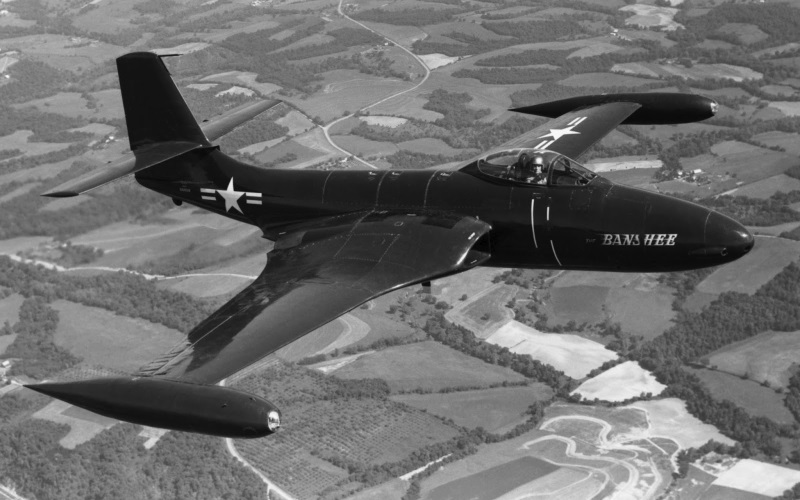
Of course, the larger XF2D-1 needed more power than the Phantom, and so the XF2D-1 was fitted with twin Westinghouse J34-WE-22 engines, with 13.3 kN (1,360 kgp / 3,000 lbf) thrust each -- almost twice the power of the Phantom's J-30s. Internal fuel supply was 3,320 liters (877 US gallons).
The initial flight of the XF2D-1 was from Saint Louis on 11 January 1947, with test pilot Robert Edholm at the controls. Trials proved satisfactory, and so the Navy ordered 56 production machines as the "F2H-1 Banshee" in May 1947, with the first rolled out in August 1948. The F2H-1 differed from the XF2D-1 in various details, such as a shallower tailfin fillet and a flat tailplane, instead of the dihedral tailplane of the XF2D-1. Following carrier qualification on the USS FRANKLIN D. ROOSEVELT, the Banshee went into service late in 1948, replacing the FH-1 in squadron service. It was nicknamed the "Banjo".
* The F2H-1s remained in firstline service long enough to be upgraded to uprated J34-WE-30 engines, providing 14.0 kN (1,430 kgp / 3,150 lbf) thrust each. However, it was obvious that further improvements could be made to the Banshee and the F2H-1 was strictly an interim type, more or less a training exercise for pilots and carrier crew, with the Navy ordering the improved "F2H-2" in August 1948.
The F2H-2's appearance was generally much the same as that of the F2H-1, but the F2H-2 was stretched by 36 centimeters (14 inches) to increase fuel capacity by 670 liters (177 US gallons). A tank with a capacity of 757 liters (200 US gallons) was attached to each wingtip. The tip tanks were fixed and could not be dropped; they could be removed by the deck crew, but it is hard to find any pictures of operational F2H-2s without the tip tanks. Incidentally, there are photos of the XF2H-1 with the tip tanks; presumably it was used to trial them.
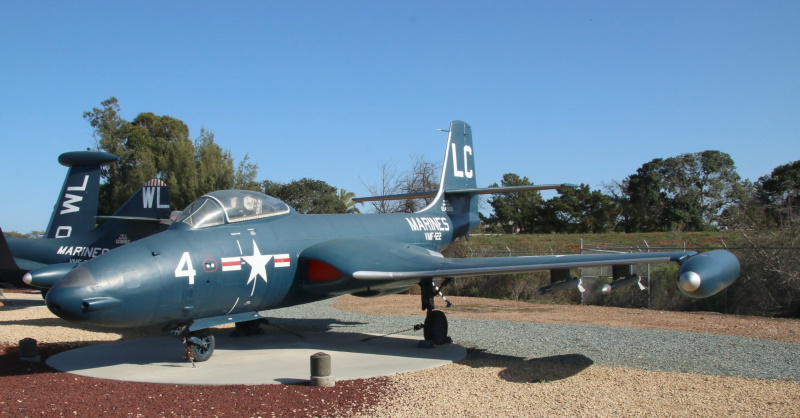
These changes brought the total fuel capacity of the F2H-2 up to 5,510 liters (1,454 US gallons). To handle the greater weight, the wing was structurally reinforced and extended slightly in span. The engines were also changed to further uprated J34-WE-34 engines with 14.4 kN (1,475 kgp / 3,250 lbf) thrust each.
__________________________________________________________________
MCDONNELL F2H-2 BANSHEE:
__________________________________________________________________
wingspan:
13.7 meters (44 feet 10 inches)
wingspan (folded):
5.6 meters (18 feet 6 inches)
wing area:
27.3 sq_meters (294 sq_feet)
length:
12.2 meters (40 feet)
height:
4.39 meters (14 feet 5 inches)
empty weight:
4,440 kilograms (9,795 pounds)
max loaded weight:
10,120 kilograms (22,300 pounds)
maximum speed:
945 KPH (590 MPH / 510 KT)
service ceiling:
14,785 meters (48,500 feet)
range:
2,375 kilometers (1,475 MI / 1,285 NMI)
__________________________________________________________________
The "kneeling" nose landing gear scheme was deleted, since it hadn't proven particularly useful in practice. While the F2H-1 had no provision for external stores, the F2H-2 featured two stores pylons inboard under each wing, for a total of four, with a typical warload being four 112-kilogram (250-pound) bombs or two 225-kilogram (500-pound) bombs. Alternatively, three stores pylons could be fitted outboard under each wing to carry a total of six HVARs.
* Initial deliveries of the F2H-2 were in 1949. A total of 364 was produced, making the F2H-2 the most heavily built version of the Banshee. A number of subvariants were built as well. The "F2H-2B" was an attack-optimized subvariant with stronger wings, allowing it to carry up to 1,360 kilograms (3,000 pounds) of external ordnance. It had no visible external differences relative to the standard F2H-2. Only 27 F2H-2Bs were built; they were often tasked with the nuclear strike mission, carrying a single Mark 7 or Mark 8 nuclear weapon.
The "F2H-2N" was a night / all-weather fighter, with the nose stretched by 85 centimeters (34 inches) to accommodate an AN/APS-19 radar. The four-cannon armament was retained, but rearranged so that two cannon fired from each side of the nose. Only 14 were built, with work moving on to more sophisticated all-weather fighter derivative concepts.
The "F2H-2P" was an unarmed reconnaissance variant, stretched by 70 centimeters (27 inches) and with a long "duckbill" nose housing six cameras, giving a length of 12.9 meters (42 feet 5 inches); the cameras could be rotated in flight to shoot obliquely or vertically. The camera ports were heated to prevent them from fogging or frosting up. A pod could be fitted under each wing outboard of the flaps to carry photoflash flares, with each pod carrying 20 flares. The cameras were designed to automatically shoot when a flare went off.
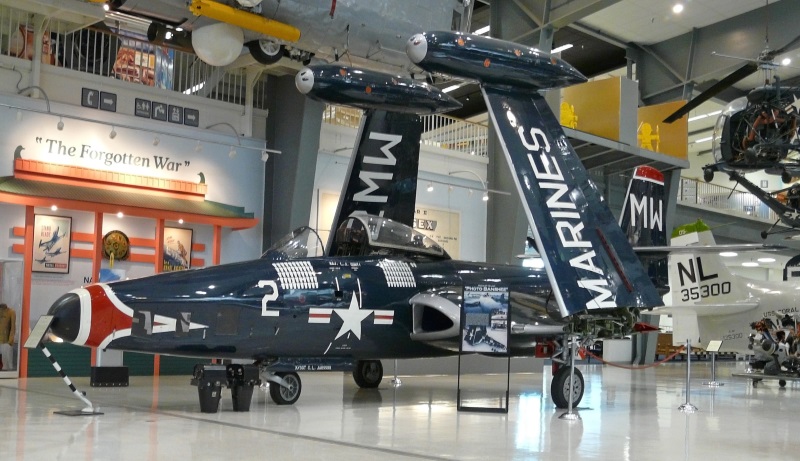
Lacking armament, the F2H-2P was the lightest of the F2H-2 series, and though almost 10% slower than a stock F2H-2 due to its bulbous nose, it had better altitude capability. A standard F2H-2 was modified as the prototype, performing its initial flight on 12 October 1950. 89 were built.
* Most F2H-2s flew in overall sea blue colors, though sometimes colorful trim was added, particularly to the wingtip tanks. Pilots generally liked the Banshee, since it had good performance by the standards of the time; handled well; while being very sturdy and reliable. It had fair range for a jet, and pilots learned to extend the range by cruising on a single engine.
The F2H-2 was in fleet service when the Korean War broke out in June 1950, but it would generally be a second-string player in the conflict, the Grumman F9F Panther taking more of the honors. The limited use of the Banshee in Korea was evidence of the fact that the war there was regarded as a sideshow to the global confrontation with the Soviet Union, since Banshee deliveries to the Atlantic and Mediterranean took priority over operations in the Korean theater.
Squadron VF-172 flew F2H-2s in the conflict off the USS ESSEX from August 1950 into the fall of 1951. The F2H-2 didn't come back for another year, when the USS KEARSARGE arrived with VF-11 in the later months of 1952. The KEARSARGE was spelled by the USS LAKE CHAMPLAIN, with VF-22 and VF-62, from the spring of 1953 up to the final cease-fire in late July. The F2H-2s fought mostly in the strike role, the type being a stable bombing platform and rugged. There were a number of losses; no Banshee claimed an air-to-air kill.
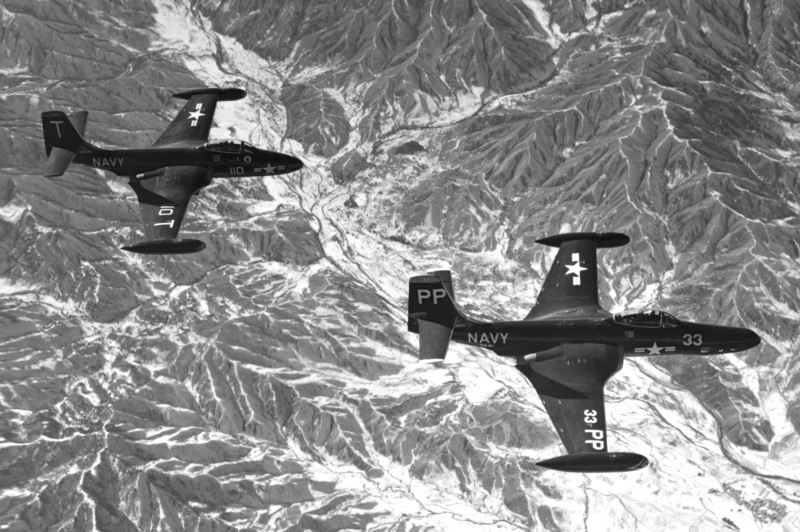
The F2H-2P reconnaissance variant was a more persistent participant in the conflict, with detachments from VC-61 and VC-62 providing photo-reconnaissance backup to naval strike elements and Marine squadron VMJ-1 providing similar service under the general command of the US Air Force Fifth Air Force. VMJ-1 was the only Marine Banshee unit to fight in Korea, it appears generally flying off of land bases. The reconnaissance mission was dangerous, particularly for post-strike damage assessment when the enemy was generally alert and agitated, and F2H-2Ps invariably had a fighter for escort -- or more than one for missions over heavily defended targets, with the fast USAF F-86 Sabres doing the escort honors in the most dangerous areas.
* Aircraft design was moving rapidly in the 1950s and the F2H-2 was quickly obsolete, being out of first-line service soon after the end of the war, but lingering in reserve service for a few more years. The F2H-2P remained in service as a first-line naval reconnaissance asset up to the mid-1950s. In mid-decade the Navy changed aircraft color schemes, and the F2H-2Ps were then generally painted in gull gray topside and white underneath.
BACK_TO_TOP* In response to combat experience and trials with the radar-equipped F2H-2N, McDonnell engineers came up with a major redesign of the F2H-2, the "F2H-3". An F2H-2N was modified as the prototype, with the initial flight of a production F2H-3 on 29 March 1952, and the type in service before the end of the year.
The F2H-3 was stretched by 2.4 meters (8 feet) to accommodate an AN/APG-41 radar and 50% more internal fuel capacity. The tailplane was moved back down onto the tail of the fuselage and, after initial prototype trials showed a tendency toward tail flutter, reinforced by triangular leading-edge extensions. The tailplane also had a 10-degree dihedral.
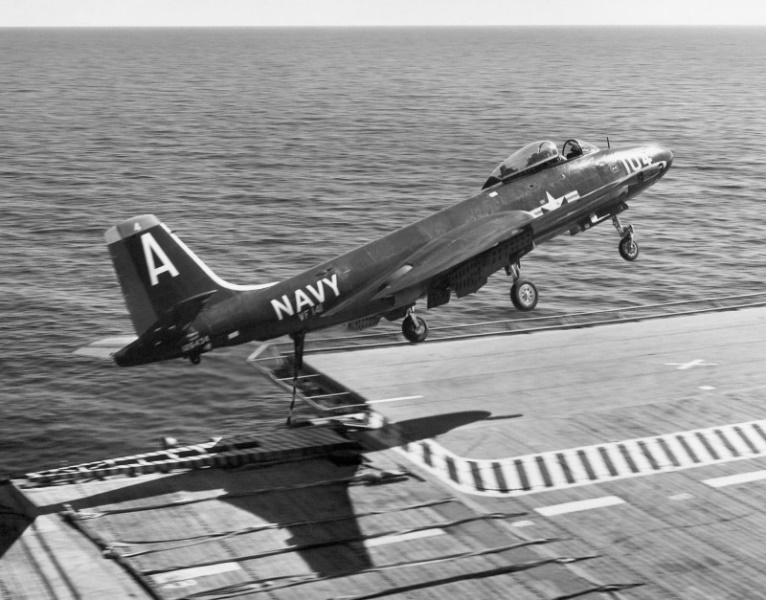
The four 20-millimeter cannon were retained, but moved back to the lower fuselage under the cockpit. The M3 cannon were updated to the improved Mark 12 or Mark 16 Hispano-type cannon firing a more powerful round, with the top cannon featuring a load of 220 rounds per gun and the lower cannon featuring a load of 250 rounds per gun. There were two stores pylons under each engine nacelle and two stores pylons under each outer wing, for a total of eight -- with some F2H-3s fitted with a special heavyweight pylon between the fuselage and one of the engines for a nuclear store.
__________________________________________________________________
MCDONNELL F2H-3 BANSHEE:
__________________________________________________________________
wingspan (no tip tanks):
12.7 meters (41 feet 9 inches)
wingspan (folded):
5.6 meters (18 feet 6 inches)
wing area:
27.3 sq_meters (294 sq_feet)
length:
14.7 meters (48 feet 6 inches)
height:
4.42 meters (14 feet 6 inches)
empty weight:
5,980 kilograms (13,185 pounds)
max loaded weight:
11,435 kilograms (25,215 pounds)
maximum speed:
945 KPH (590 MPH / 510 KT)
service ceiling:
14,200 meters (46,600 feet)
range:
2,760 kilometers (1,715 MI / 1,490 NMI)
__________________________________________________________________
The wingtip tanks were reduced in size to 644 liters (170 US gallons). The tip tanks were not always fitted in operational service, and plenty of pictures show F2H-3s flying without them. An inflight refueling probe could be fitted for ferry flights and the like by yanking the upper left cannon, then installing the probe through the cannon port. To handle the higher weights, uprated J34-WE-36 turbojets with 14.5 kN (1,475 kgp / 3,250 lbf) thrust each were fitted. There was talk of an "F2H-3P" photo-reconnaissance variant, but it didn't happen.
Even while F2H-3s were being rolled out in Saint Louis, a modest improvement of the F2H-3 was in the works. The "F2H-4" was all but impossible to distinguish from the F2H-3 externally, the major changes being fit of further uprated J34-WE-38 turbojets with 16.0 kN (1,630 kgp / 3,600 lbf) thrust each and Westinghouse AN/APG-37 radar. The new engines provided about a 5% increase in speed and a 10% increase in range, but not everybody was impressed by the new radar.

* A total of 250 F2H-3s was built to shutdown of the Banshee production line on 30 October 1953; F2H-4 production of 150 machines had already been completed in September. The Marines were only provided with the F2H-4 in first-line service, though some Marine Reserve squadrons did fly Navy F2H-3 hand-me-downs. It doesn't appear that the F2H-3 or F2H-4 ever fired a shot in anger, though there were running incidents of air battles along the borders of Communist countries during that era that were kept very quiet.
The F2H-3/4 gave the Navy the service's first all-weather jet fighter, with the types serving through the 1950s. Early machines retained the overall sea blue color scheme; some flew in anodized aluminum metal finish for a time, though that led to corrosion problems, and in mid-decade they went to the gull gray / flat white color scheme. Late in the decade, the F2H-3/4 were armed with twin Sidewinder air-to-air missiles. The F2H-3/4 was out of service by the end of 1961, but a number were still in mothballs in 1962 when the common Air Force / Navy aircraft designation scheme was introduced, and so the F2H-3 and F2H-4 were redesignated to "F-2C" and "F-2D" respectively.

* From 1955 into 1958, the US Navy passed on 39 F2H-3s to the Royal Canadian Navy, and these aircraft equipped two squadrons on the carrier HMCS BONAVENTURE. Refueling kits were not provided. These aircraft were painted in dark sea gray topside and light gray on the bottom, and carried Sidewinders from 1958. There were a number of accidents early on that led to grounding of the Canadian Banshee fleet; the incidents were traced to metal fatigue in the wing fold, with the problem fixed and the aircraft returned to flight. The last of these machines were phased out in 1962. Although a number of Banshees survive as static displays in museums and the like, none remain in flying condition.
* The following list gives Phantom and Banshee production and variants:
That gave a total of 951 Banshees, including the prototype. Although a number of Banshees survive as static displays in museums and the like, none remain in flying condition.
BACK_TO_TOP* I tend to find some of the first-generation combat jets like the Banshee to be particularly appealing. There was a certain solid, uncluttered cleanliness to many of these aircraft that make them very pleasing to the eye.

* Sources include:
Some details, particularly production quantities, were obtained from an online article by aviation enthusiast Joe Baugher.
* Illustrations details:
* Revision history:
v1.0.0 / 01 jan 07 v1.0.1 / 01 dec 08 / Minor corrections. v1.0.2 / 01 nov 10 / Review & polish. v1.0.3 / 01 sep 12 / Review & polish. v1.0.4 / 01 jul 14 / Review & polish. v1.0.5 / 01 jun 16 / Review & polish. v1.0.6 / 01 may 18 / Review & polish. v1.0.7 / 01 mar 20 / Review & polish. v1.0.8 / 01 oct 21 / Review & polish. v1.0.9 / 01 mar 23 / Review & polish. v1.1.0 / 01 feb 25 / Added drawing. (+)BACK_TO_TOP
